Newsletter 149, February 2024

In this issue
Notices
NZFFA Executive election at AGM 2024
Nominations are hereby invited for the following Executive Vacancies.
- NORTH ISLAND EXECUTIVE MEMBER (Three-year term)
(Tim Forde is retiring by rotation) - SOUTH ISLAND EXECUTIVE MEMBER (Three-year term)
(Laurie Bennett is retiring by rotation)
2024 Executive Election - Nomination Form
Rules for Nominations:
- All Candidates must be financial members of NZFFA.
- Any Branch or Special Interest Group can nominate and/or vote for the President’s and the At Large vacancies.
- Nominees must sign their consent and nominations must be received by Head Office, by 27 FEBRUARY 2024.
- President’s Vacancy
Any nominee for President needs to have completed a minimum of one year (counted from conference to conference) on the Executive, or as Branch or Action Group President, Secretary, Treasurer or Councillor. - North Island and South Island Vacancies
a. Branches can nominate and/or vote for the Island-specific vacancies in their particular island.
b. Special Interest Groups can choose to nominate for vacancies in either the North Island or the South Island (but not both in the same election).
c. Special Interest Groups can choose to vote in the elections for either island (not both) but if they have made a nomination they can only vote in the election for the island of their nomination.
d. Candidates must reside in the island they have been nominated for.
Gisborne Extension to the Hawke's Bay Conference
This begins on Sunday 14th of April 08.30 with a visit to the Holt Forest near Tutira. This is a marvellous arboretum with 16 metre high pruned douglas fir, majestic redwoods, lawson cypress, Japanese cedar and many more. It was planted from 1938 onwards with the aim of "creating a collection of fine trees".
We will have a stop at Wairoa for lunch and then on to Gisborne. Possibly via Arapapa, possibly via Nick Pollocks place. On Monday the 15th we go to Eastwoodhill in the morning and visit Knapdale in the afternoon. If at all possible we should also visit the Ross Estate near Manutuke where David and Richard Clark have established a wide variety of species.
Participants can fly out that evening or the next morning. For those who stay on Monday evening there is a free dinner at Knapdale.
We have the ability to provide free transport for 5 participants. You pay for your own accommodation and there will be minimal costs involved.
Please email kees.weytmans@gmail.com or txt/phone on 0274-465658 for enrolment or more information.
Kees Weytmans
0274-465658
Te Uru Rakau website survey
Do you have 4 minutes to help improve the information Te Uru Rakau – New Zealand Forest Service provides on our websites?
We are inviting those who have, or are considering, planting trees to take part in a 4-minute, anonymous survey to find out what information is important to you.
Your responses will help us improve content on our websites. Take the survey now
Events
For more information on these events, they are posted on the NZFFA website »
Branch secretaries, please make sure you notify head office of any branch or action group events.
- Bay of Plenty Branch AGM & Field Day - Bellamy Farm Saturday 17 February 2024 Venue Paul & Rita Bellamy Farm. 71 Clark Rd (16.5km up Rangiuru Rd from SH2, or 18.5km along Te Matai-Rangiuru Rd from SH36) RD8, Te Puke…
- North Canterbury Branch AGM & Field Day - Ngaroma Thursday 22 February 2024 10am Bruce and Heather Macfarlane's sheep and beef farm, Ngaroma, is at the north end of the Hawkswood Range, bounded by Conway River and the Kaikoura…
- NZ Farm Forestry Association, Northland Branch – 2024 AGM Notice Annual General Meeting 11:00 am, Sunday 25th February, Whangarei 59 Clapham Rd, Whareora Bob Kennedy’s residence Any items to be considered for the Agenda, please reply to Peter Coates…
- Wairarapa Branch Field Day & AGM - Marangai Sunday 25 February 2024 10am Field Day: Cyclone Gabrielle in the Tinui Valley, 12 months on Marangai, Rapid No 3075 Masterton/Castlepoint Road Marangai is a large family-owned sheep and beef…
- 2024 Forest Biosecurity Conference: Threats, innovation and control strategies As the risks to our forests from biological threats continues to grow, it’s increasingly important for forest owners, forest nurseries, and those that work in, or rely on our forests, to take…
- Webinar: Biomass-fuelled heat plant and emerging technologies relevant to Australasia. March 12, 2 pm. Over the last decade, an increasing number of biomass boilers have been installed to replace fossil-fuels and in new applications. Today, tailored wood and biomass-fuelled heat plants are a future-proof, reliable and profitable investment. This webinar will discuss the latest technologies and potential solutions, including fuel-particular supply methods and customer-specific operations. Potential investors and biomass residue providers should attend this webinar to understand the latest technologies and the important attributes of different residues and systems before providing renewable biomass fuels. Register here https://us06web.zoom.us/meeting/register/tZMrf-uppzktHNLucfAM-JH37i3IjxBg1I-8#/registration
- South Otago Branch - Alternative Species Field Day Thursday 14 March 2024 Starting at 1.30pm at the the Cullen farm woolshed, 250 Glenomaru Valley Road. Neil Cullen will give an introduction to the land, the what and why of…
- Tree Growers Tairawhiti - Gisborne/East Coast Branch AGM Sunday 24 March 2024 Please note in your calendars that the Tree Growers Tairawhiti (NZFFA Gisborne/East Coast Branch) AGM will be held on Sunday 24 March 2024 at Wensleydale Station. More details…
President's report
2024 is already shaping as a busy year with the Executive meeting in the first week of February where much discussion revolved around what positions FFA will take in regard to the vote on renewal of Forest Growers Levy Trust’s mandate which will happen later this year. Consultation meetings with forest growers are scheduled for April so a working group is preparing position papers to be approved by Executive and Council before then. Discussions with levy partners and the Secreteriat will hopefully result in an agreed set of proposals going out for consultation.
Tim Forde and his team have a great Conference planned in April which deserves all our support. With what that part of the country experienced a year ago with Gabrielle, the theme Resilient Landscapes is an obvious introduction to the role that trees on farms have to ensure the long term future of farming and forestry.
We are promoting NZFFA at both Southern Field Days at Waimumu and Central NI Field Days at Manfield so call in if you are attending. The schedule for our Alternative Species Field Days around the country will be advertised shortly and these will be a good chance to show land owners the range of species options that are available in each region.
We are appointing Matt Highway as our COO this month on a short term contract. He will concentrate his time on building partnerships with various organisations, looking for alternative funding sources for NZFFA, and generally advocating for our Association. Matt will be at Conference to introduce himself and meet members.
Neil Cullen
Blogs
- What would the public think - soil degrader or enhancer? Grant Hunters blog, February, 2024. On 17 December the public awoke to headlines: "New research uncovers how much damage pine forests are doing to our soil". (Adam Hollingworth, Newshub) Ravensdown CSO Dr. Ants Roberts - known…
NZFFA members can set up their own blogs on the NZFFA website. Email Dean.
The Silviculture Micro Innovation Challenge
The Silviculture Micro Innovation Challenge is here. Got a great idea to solve a silviculture problem or to make planting, pruning, and/or thinning better, easier, safer? It could be a new tool, an improvement to an old tool, a different way of doing something, or a novel use of available technology… The only limit is your imagination!
Be in to win up to $15,000 to turn your idea(s) into reality (that you get to keep and use.)
Here’s a video link with a bit of detail https://youtu.be/81cmaV_1Jq8
You can register your ideas at www.microinnovation.co.nz via your smart phone or computer. Or if it’s easier, you can email, text, or call me with a brief summary and I’ll register on your behalf brionny@microinnovation.co.nz
Keep it simple. Just tell us the problem you want to fix, your solution in a few words, and upload some pictures or drawings. Ideally, you can build your idea within 10 weeks for up to $15,000 NZD – remember this is for your first working prototype.
Ideas already built still count, and you can submit as many ideas as you like. Anyone can enter – workers, crews, contractors, friends, family, engineers, manufacturers, forest owners, students...
The Challenge is live until Friday 8 March. ENTER NOW www.micronnovation.co.nz
Battery Powered Chainsaws in Waste Thinning
This work, funded by the Forest Growers Research Precision Silviculture Programme, compares conventional petrol powered chansaws with the latest generation of battery powerd chainsaws, for thinning radiata pine.
Rob Prebble, Richard Parker, John Henry and Scott Fargher undertook the research and produced a report for FGR in July 2023.
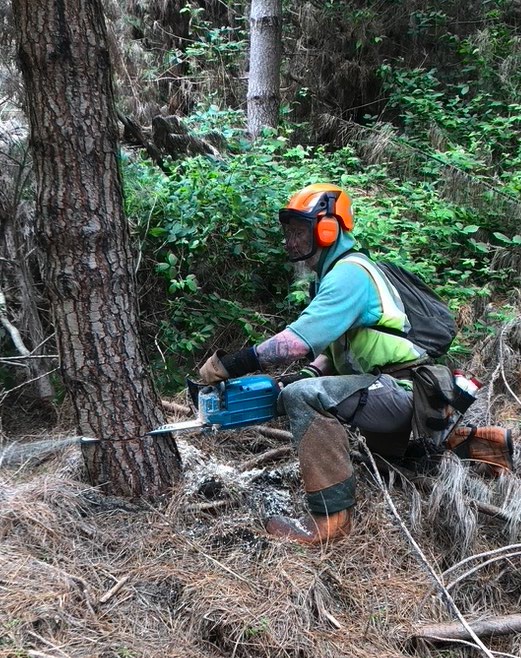
Chainspeed was actually slightly greater for the stihl battery saw than the stihl petrol saws, but power was lower. However, in their favour was the reduced noise and vibration, along with not being exposed to carbon monoxide from exhaust fumes.
The time taken to change a battery was significantly faster than pouring petrol into the fuel tank. used significantly less bar lubricating oil
Bar sizes were 20" for the petrol stihl and 16" for the battery stihl. The thinners were used to and preferred the longer bars on the petrol-powered saws because they could reach further and reduce the cutting time. To me it was a shame that the researchers didn't control for this variable by making bar sizes the same for both types of chainsaw.
Because battery run time ranged between 25 and 45 minutes, up to 12 batteries would be required for a full days work (6 1/2 hours), with overnight charging using a specially constructed trailer.
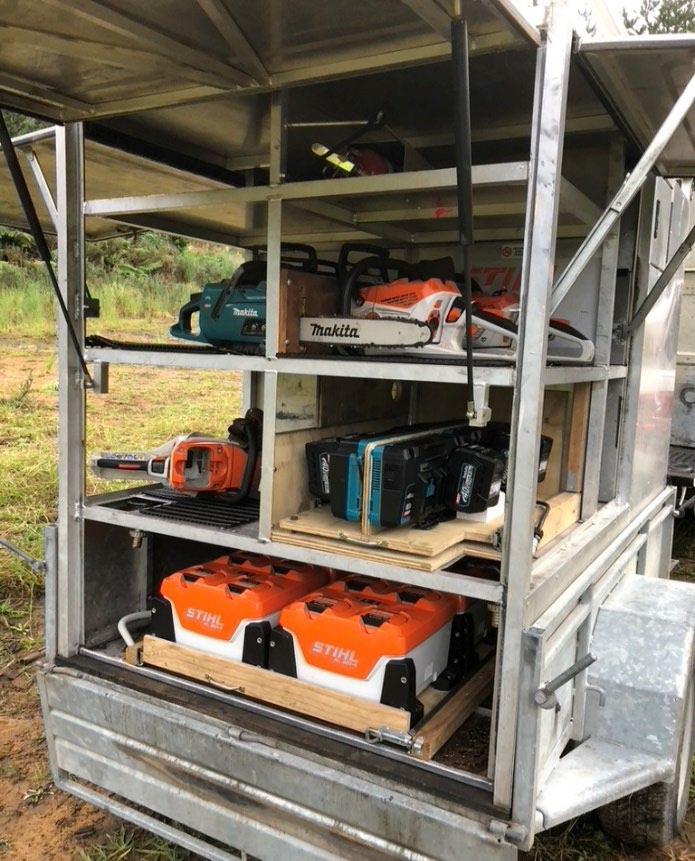
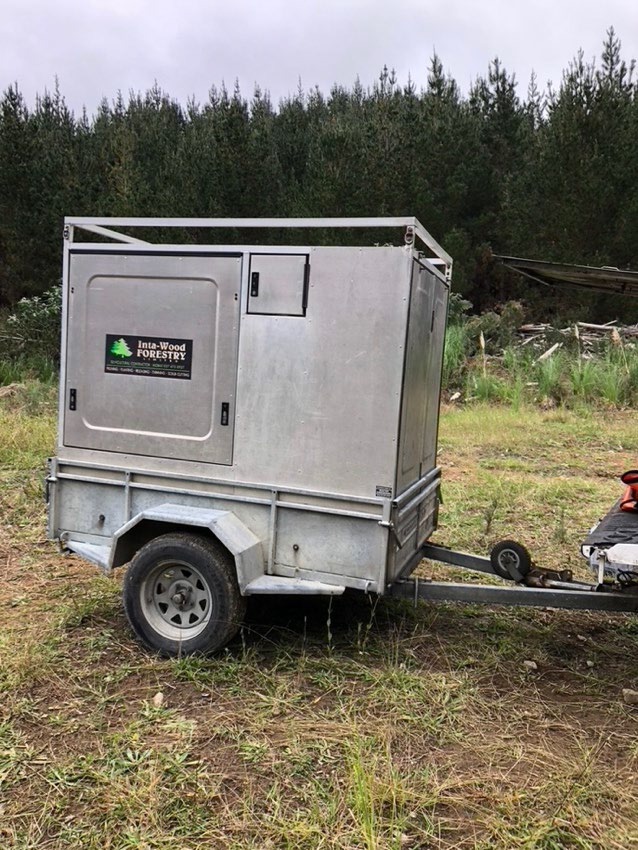
The report compared cutting time vs diameter which I don't believe is appropriate. Chainsaws cut by area, so cutting time increases more than proprtionally as diameter increases. I did a comparison using average fell time vs basal area and found the petrol chainsaws were only 8% faster than the battery chainsaws. That's not a deal breaker.
However, carrying 5 or 6 batteries in their back packs added 10 - 12kg weight. I'd suggest carrying one or two spares between breaks and having a basecamp for the rest. Operators also did not like the safety mechanisms in the Stihl battery chainsaw and the shorter bars on the battery saws were a distinct disadvantage when working in trees the size that they are usually required to fell.
My impression from reading the report is that the differences in performances aren't the deal breaker, but rather the charging method and cost for batteries. The stihl petrol chainsaw will set you back $2965, whereas the battery saw, 4 x batteries, a charger and a portable generator would set you back $6000. So if you don't want to be exposed to the carbon monoxide fumes, the noise and vibration of a petrol chainsaw, then battery chainsaws look like a viable option for thinning radiata plantations, provided you are prepared to spend more. Sounds a bit like comparing electric cars with petrol cars!
Dean Satchell
South Otago field day - Pan Pac Mill and McLeary's logging operation
We were very fortunate to get a slot for a visit to the PanPac mill at Milton, kindly arranged for us by Neville Hills of Forest Management Ltd. This took place on the morning of 8 December, but as it was at short notice, there was not a big turnout, just about 16 people. That actually suited the presenters for the tour – Peter Mahews, Sawmill Coordinator and Ant Conway, Operaons Manager – as there were fewer of us to herd around the mill.
In the introductory talk, we learned that PanPac is owned by Oji, a Japanese paper company. PanPac has been in Milton for seven years but much longer in NZ: 50+ years in Napier, although that mill is currently not working fully due to damage caused by Cyclone Gabrielle. The Napier mill is four and a half times the size of the Milton one, which seemed huge anyway, and at Milton 900 tonnes of wood a day is cut. The sawdust and bark from the logs fuel the boiler to dry the timber. The result is 12 trucks a day go out with lumber, and seven trucks a day go out with chips. The mill holds about a week’s worth of log supply, as they prefer fresh wood.
PanPac also prefers wood which has been well looked after, and of higher grades such as pruned, partly pruned and A grade. The mill can take a maximum diameter log of 61 cm for pruned, or 55 cm for A grade, and they are constrained to a 4 m length. They cannot handle oversize logs as they will jam the mill, so if any of these arrive they are carted to the port and sold at a loss. At the other extreme, a log with too small a diameter wastes the mill’s time as it takes up the place of a larger log. PanPac is strict on the shape and form of the log, and want people to look after their trees and prune them well.
As the log starts its journey through the mill, it is scanned, generating a 3D image from which the computer figures out the optimum cut. It is then cut into planks, trimmed automatically and sorted into bins, stacked, and put out into the yard in readiness for drying.
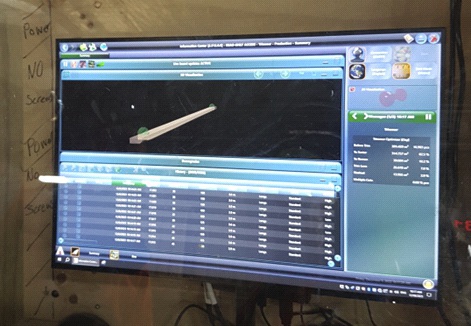
3D representaon of the cut
54% of the log volume is recovered into saleable lumber, and 24% is made into chips which go to the Mataura mill for MDF. Ant Conway noted that the biofuel market is starting to change, with all the boiler conversions recently. The lumber is shipped to various countries around the world – the high grades go to the US and Europe, while the lower grades go to Asia, Thailand and Korea for example. The volume going to China these days has reduced. PanPac deals with just radiata pine, producing appearance-grade timber only, not structural. If a larger mill is built at Milton in the future, it will be possible to process Douglas-fir too.
Photos from the mill:
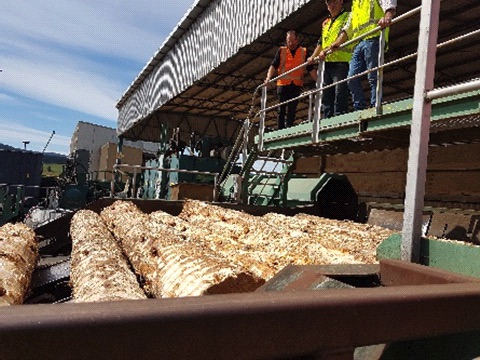

It was incredible that, once a log is loaded into the mill, it takes just five minutes to pass through and end up as timber in the yard. It then goes into the kilns for drying which takes approximately two weeks for larger beams. There is a whole science behind drying timber.

PanPac sharpens their saws on site, and re-tips them when needed. A saw runs for two days before needing to be sharpened. PanPac has its own spring and bore which supply the water to keep the saws cold while they work, and also supply the boiler with the water it needs for the drying/steaming process.
FSC-certified wood is preferred at the mill, but as there is no price premium when PanPac sells the wood, there is thus no premium to pass on to the supplier. However, it increases PanPac’s market share in the timber market.
It was interesng that the timber is stacked for the drying process using fillets of LVL wood to separate the layers. These are reused several times, being very strong and able to withstand the drying/steaming process again and again.
Altogether, a fascinating look around the mill, seeing where our trees end up.
Next, we saw where some of those logs were coming from – Alan and Jo McLeary’s farm at Puerua, south of Balclutha, which SOFFA had last visited in 2019.
We were met there by Neville Hills of Forest Management Ltd who is doing the harvest management for the McLearys, and Baz (Barry) Winders of Winders Logging and his team who are doing the actual logging. Baz started in August logging a 1.4 ha block of pine, and Alan credits Baz’s care and expertise for netting 650 tonnes/ha and $36,000 for that small block. Although they were good trees, Alan highlighted the importance of the logging operator and spoke very highly of Baz. He liked his honesty, the care that was taken with the logging - fences remained in place - and the cleanliness of the logging team who left no rubbish lying around: traits which are well suited to a logging job on a farm.
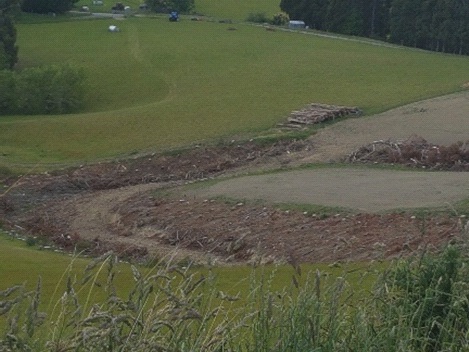
1.4 ha block
After this successful logging, Baz carried on to log about 13 ha of 26-year-old pine on a hill. Alan had thinned this block himself. He mentioned that the log prices were not flash, but as he had the loggers at his farm, available trucks, and the ability to send logs to PanPac rather than the wharf, he decided to log anyway. The decision was probably helped by wife Jo kicking his shins as she wants a new house.
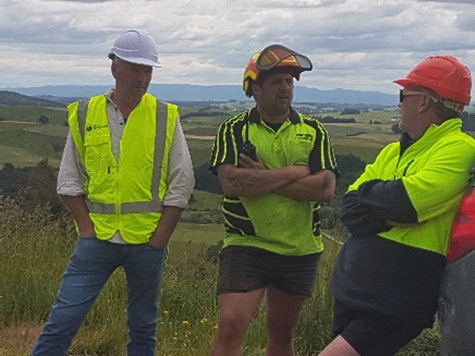
Baz Winders in the centre, Al McLeary on the left, Scott McKenzie right
Alan had put the logging road in a few years ago. The type of road was discussed at a farm forestry field day there in November 2019; Alan did not include any of the recommendations, funnily enough, but there were no problems with the road as its had a few years to bed down. Hendersons were the trucking company – Alan and Jo found them very considerate, they would slow down at the house and stop for chickens crossing the road.
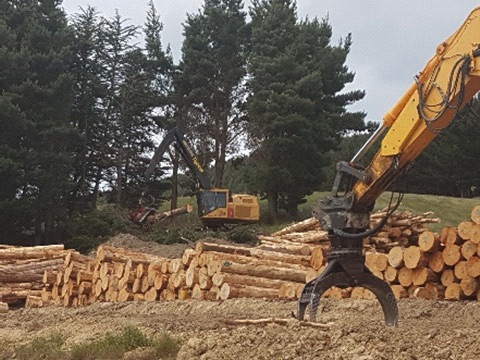
Logging a small area just by the skid site
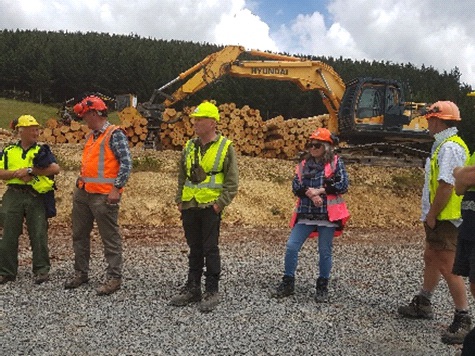
Neville Hills in the centre, Jo McLeary to the right
Apart from the logs to PanPac, the slash is also used, taken to Azwood in Milton for processing into chips which will feed the Danone boilers at Greenfield. This leaves much less mess on site and although there’s no money in it, it is got rid of.
The McLearys recently bought a block in the Milton area to help spread the logging rotation and NZU's. Units will have to be repaid following the current logging, but Alan will replant and earn more credits, getting a cycle going. He also liked the concept of keeping the forestry industry ticking over, at this time when there is less logging happening.
The logging job will finish around the end of January. That seemed some way off but the upside is there is a chance the log prices will go up before then. Windrowing has already started, and Alan plans to spray before replanting next winter.
It was great to be back at the McLearys’ place, and good luck to them for a successful and profitable conclusion to the logging. And fingers crossed that Jo finally gets her new home!
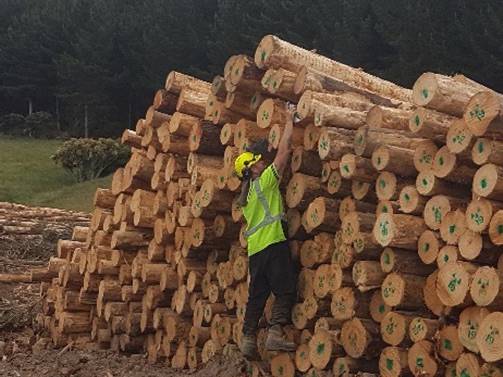
Marking the logs
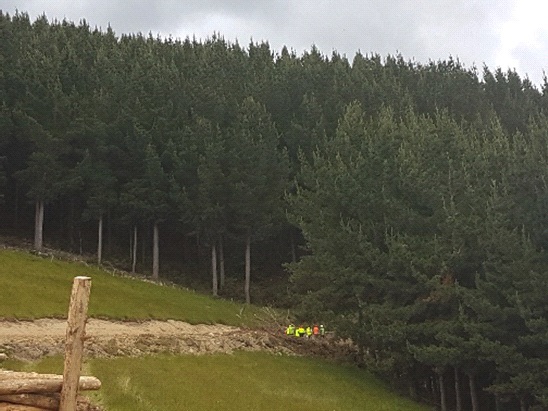
Height of remaining trees put into perspecve by hi-viz- vest-wearers
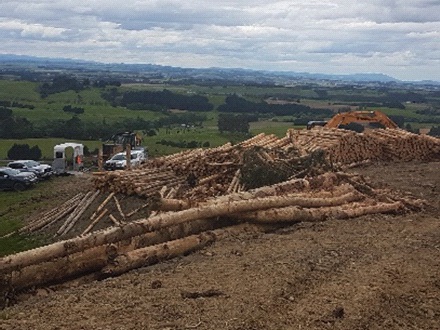
The skid site and a great view beyond

Harvested and windrowed area
Wellington field day to Dave Gratton's forest
The Wellington branch had a day out at Dave Gratton’s forest on Sunday 11 February, before holding its AGM. Dave won the 2023 North Island Farm Forester of the Year award, and this was a chance to visit his property near Upper Hutt and hear him outline what he had done, why, and how successful it had been.
Dave’s land is bounded by the Akatarawa river to the east, which winds through a deep but comfortable gorge leaving him with alternating cliffs and river flats. These rise steeply to a gently graded plateau to the west. The flats are mostly grazed, the cliffs are mostly in native forest and the plateau is mostly in pines, but there are experimental plantings throughout.
We assembled near the implement sheds at 10 for a briefing and a quick look at the trees around the homestead, which include redwoods planted in 1982 and a range of Abies planted in 2000. These were planted for interest rather than timber but are growing strongly in the gravelly flats amongst the sheep. A steep drive up a good gravelled road took us to an area of regenerating native forest, where Dave had planted cryptomeria, redwoods and macrocarpa in lines through the scrub. Now 15 years old, the exotics had broken through the canopy and were starting to show good form. This area was planned for continuous cover forestry, and will be harvested one tree at a time,
Down the hill we found another set of flats, where Dave had planted native trees along the riverbank and protected them from grazing. Most are not really pretty but they are sturdy and healthy, and support a range of creepers, ferns, flowers and epiphytes.
Behind that, a QE ll covenanted area of native bush has been fenced off, which Dave said gave him some protection against officials who had argued that much of his forest should be in an SNA.
On a second grassy terrace above the river Dave had put in a trial for the Cypress Development Group, planting 20 rows of 10 clones to see how they performed. Some were clearly more palatable than others as there were several gaps where trees should have been. However some of the young cypresses were looking really good and already 2 metres tall at age 2. There was a lot of discussion about the clones, how they were performing and the problems of deer and pigs.
After winding up the road to the plateau we had lunch at the skid site where the firewood contractor worked, and admired the shed, machinery and bin system. From there it was a short walk to last year’s harvested area, where Guadeloupe and Monterey radiata had been damaged by storm winds of up to 140 km per hour, but still yielded 700 tonnes per hectare.
In Wellington you can’t have everything – with deep soils and a good rainfall, you have to expect a bit of wind now and then. Given the level of damage there was some discussion of what to replant, but since radiata grows well there, it will probably be replanted in the same.
Off the crest the land sloped gently to the west, and in the more sheltered dips Dave had 30 year old pruned radiata growing straight as gun barrels and about 40 metres tall. There was a strong native understorey and soft damp soils despite the lack of rain. It was a lovely place to be.
After that the AGM brought everyone back to reality. The branch was in good shape, the committee was re-elected, we enjoyed a cup of tea and we all drove home. But imagine, if everyone had a forest, what a wonderful world.
Howard Moore
|
President: Neil Cullen president@nzffa.org.nz Newsletter editor: Dean Satchell dsatch@gmail.com National Office: Liz Chamberlain admin@nzffa.org.nz Phone: 04 4720432 |
Members |
| Disclaimer: Personal views expressed in this newsletter are those of the writers and do not necessarily represent those of the NZ Farm Forestry Association. | |
